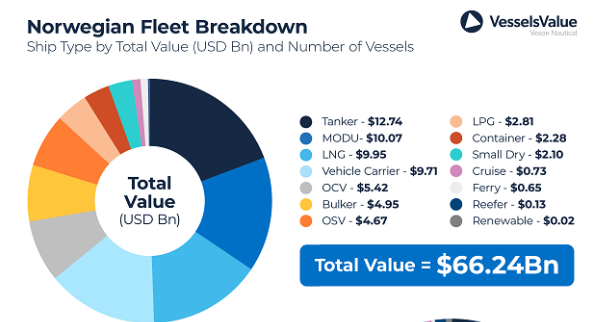Norway sets the bar high with green orders, reports VesselsValue
As the shipping world prepares to descend on Oslo next week for Nor-Shipping 2025, Veson Nautical take a look at the Norwegian fleet which is currently valued at USD 66.2 bn using its VesselsValue data.
Thanks to government-backed initiatives such as Enova, who offer financial support to facilitate the green transition, Norway is ahead of the game in sustainability when compared to the rest of the world, it says. Of the vessels currently on order by Norwegian companies, 46% are being built with dual-fuel capabilities, compared to just 27% for the rest of the world.
Within the Norwegian orderbook, all vessels, except LNG carriers which are inherently dual fuel, show a notable trend. 100% of the Vehicle Carriers on order, a total of 39 ships, are dual fuel. This is primarily due to the nature of their cargo: factory-new OEM (Original Equipment Manufacturer) light vehicles, including EVs (Electric Vehicles). OEMs increasingly prefer to transport both light and heavy new vehicles on cleaner vessels that offer lower emissions.
As a result, the Vehicle Carrier sector has seen a higher proportion of dual-fuel vessels ordered compared to other shipping segments.
The second highest percentage is the LPG sector where seven LPG vessels have been contracted, equating to c.64% of the orderbook, compared to 48% globally. In third place is the OCV sector in which, 59% of the fleet on order will be dual fuel, compared to 18% for the rest of the world.
Also noteworthy are the Tanker and Bulker fleets which each have a share of 26% and 21% respectively, compared to just 12% and 7% for the remaining orderbook.
Tankers are the most valuable sector within the Norwegian fleet, with a total value of USD 12.74 bn; this is also the second largest fleet with a total of 347 vessels.
With a value of USD 10.7 bn, the MODU sector is the second most valuable with a total of 56 vessels. LNG ranks third with 57 vessels valued at USD 9.95 bn. In fourth place is the Vehicle Carrier sector, valued at USD 9.71 bn with 135 vessels, and followed by the OCV fleet valued at USD 5.42 bn and 76 vessels.
Also noteworthy is the Small Dry sector which has the largest fleet in terms of vessels numbers with 369 vessels and valued at USD 2.1 bn.
In terms of S&P, Odfjell Tankers were the biggest spenders of the last 12 months with their purchase of 11 Handy chemical Tanker vessels and a value of USD 685 mil. In second place is Nordic American Tankers who have bought four Suezmax Tankers with a market value of USD 282 mil.
MPC Container Ships are in third place, splashing out USD 227 mil on six Panamax and Post Panamax Container vessels, followed by Avance Gas who spent USD 217 mil on two modern VLGC LPG ships. Ocean Yield are in fifth place, purchasing three vessels for USD 207 mil.
Avance Gas top the sellers list, as the company winds down, offloading 16 LPG vessels over the past year with a market value of USD 1.3 bn. In second place, Knutsen OAS Shipping sold three large LNG vessels valued at USD 679 mil, followed by Ocean Yield who sold 15 vessels with a value of USD 678 mil comprising of eight Tankers, two Bulkers, four Container ships and one LEG vessel.
Hoegh Autoliners is in fourth place with their sale of two Car Carriers valued at USD 184 mil. Nordic American Tankers rank fifth, with their sale of four Suezmax Tankers, valued at USD 176 mil.
Knutsen OAS shipping is ranked first in a list of the top 10 Norwegian owners with a fleet value of USD 6.81 bn. Their fleet consists of 20 live LNG vessels and a further 13 on order. Borr Drilling rank second with a value of USD 4.58 bn, consisting of 24 MODU vessels.
Wallenius Wilhelmsen has the largest fleet with 56 vessels both live and on order and a total value of USD 4.25 bn—the fleet consists entirely of Vehicle Carriers. Ocean Yield came in fourth place with a value of USD 3.18 bn and the second largest fleet of 44 vessels that spans across the Bulker, Tanker, Container, LPG, OCV and OSV sectors. BW LNG is ranked fifth with a value of USD 2.99 bn and consists of 22 vessels.
The latest data underscores Norway’s position as a leader in sustainable maritime innovation. With nearly half of all newbuilds featuring dual-fuel capabilities, well above the global average, Norwegian companies are setting a high bar in green shipping. The country’s diversified fleet, led in value by Tankers and MODUs, demonstrates strength across sectors, while major players like Knutsen OAS and Borr Drilling continue to drive significant investment and fleet expansion. Norway’s forward-looking strategy, backed by proactive government policies, solidifies its standing at the forefront of the maritime transition.

